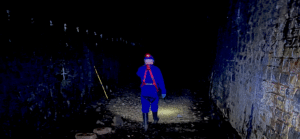
The Rhondda Railway Tunnel – From Victorian Feat to Potential Walking/Cycling Path
The Rhondda Tunnel in Wales stands as a testament to Victorian engineering prowess and the ever-evolving needs of transportation. Built over five years and opened in 1890, this 3,443-yard tunnel was once a crucial railway link. However, its story took a turn in the late 20th century, leading to its closure and current state of disuse.
The Tunnel’s Past
The Rhondda Tunnel, a 2-mile marvel of Victorian engineering, carved its way through Wales in 1890. It served as a vital railway link for nearly eight decades before succumbing to closure in 1968 due to alleged safety concerns and changing transportation needs. By 1982, the entrances were even buried under colliery waste, leaving the tunnel itself largely forgotten.
Enter the Rhondda Tunnel Society (RTS)
Recognising the historical significance and potential of the tunnel, the Rhondda Tunnel Society was formed. Their vision: to transform the Rhondda Tunnel into Europe’s longest walking and cycling path.
Challenges and Progress
A significant hurdle was ownership. The tunnel belonged to the Department for Transport, which couldn’t directly reopen it. The RTS commissioned a detailed examination in 2018, revealing the tunnel to be in surprisingly good condition. This boosted their case, and estimates suggested the project would cost £14.62 million (May 2023).
Public support has been crucial. The Society has actively engaged with local communities and garnered significant political backing. They’ve even secured funding for further assessments and secured ownership of a plot of land near the entrance, envisioning it as a visitor centre with a park.
The Future Beckons
The Rhondda Tunnel Society’s plans are ambitious. They aim to create a unique visitor experience catering to all ages and abilities. Bike and buggy rentals, alongside potential electric vehicle options, are on the table. Additionally, a micro-hydro scheme is being explored to provide sustainable power for the tunnel and visitor centres.
Impact and Significance
The project holds the potential to be transformative. It could:
- Boost Economic Activity: Creating jobs during construction and attracting tourism could significantly benefit the surrounding deprived wards.
- Improve Connectivity: The tunnel would provide a safe and scenic route for walkers and cyclists, connecting previously separated communities.
- Preserve History: The restored tunnel would stand as a testament to Victorian engineering prowess and the region’s industrial heritage.
Rockall to the Rescue
A few years back, Steve Jones, one of the Rhondda Tunnel Society’s consulting engineers, needed to source equipment to allow the team to gain access to the tunnel. After some searching, Steve landed on Rockall Safety, a local Welsh safety equipment company. Following some initial liaising, Rockall Safety were able to provide the RTS with the equipment best suited to their entry needs. Firstly though, Rockall had to get the RTS team into the workshop to show them how to properly use what they were equipping them with. Roughly one year in, Rockall Safety’s Managing Director Lee Brown, decided to eliminate all costs associated with the equipment and the calibrations needed, to allow the tunnel project to progress without the worry of the cost of essential equipment.
Recently, two members of the Rockall Safety team were able to get kitted up and go down into the tunnel to see the historic site. Emma Curthoys (social media coordinator), and Adam Perry (business development manager), walked the 2-mile tunnel in its entirety, gathering footage and images and seeing the historic site first hand.
The Path Ahead
The Rhondda Tunnel Society is actively seeking ownership transfer and planning permission. With continued public and political support, their vision of a revitalised Rhondda Tunnel as a beacon for recreation, tourism, and economic development could soon become a reality.
Plans for the tunnel moving forward will involve creating an extension to the tunnel leading from the older buried portal, which will open at a new portal further down the path. Further plans include bicycle and buggy hire for the public to use through the tunnel, a shuttle bus for those who only want to walk the one way, and gallery space for art, and displaying pieces of history.
According to their website, they aim to “create a visitor experience that attracts people of all ages and abilities, with special emphasis on giving a great experience to disabled and elderly visitors who will be able to use electric and adapted vehicles, some multi-seaters”.
If you would like to read up more about the tunnel or become a member of the Rhondda Tunnel Society, you can visit their website:





